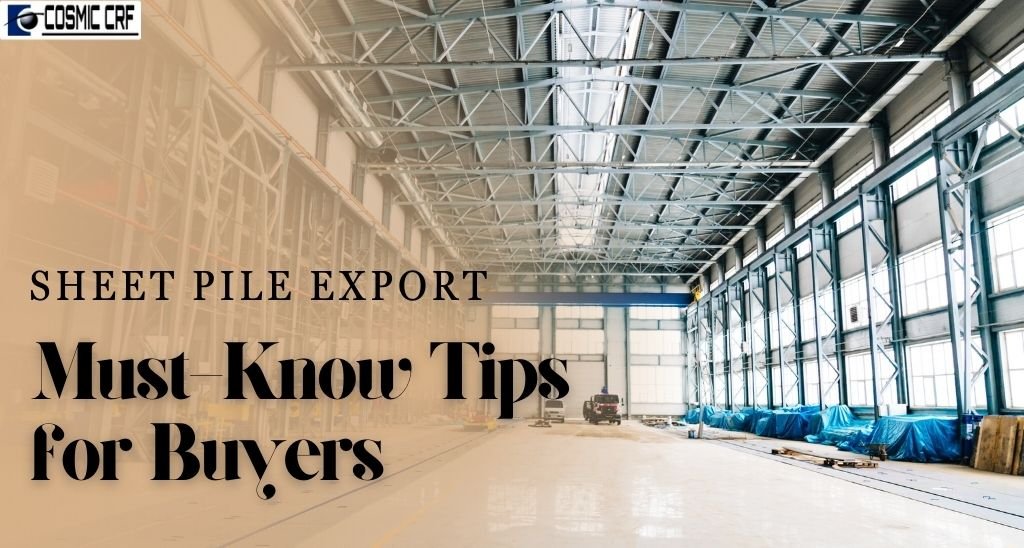Ordering concrete sheet piles across borders involves more than just choosing a profile.
You’re dealing with long lead times, vessel loading slots, and strict project schedules.
One error in the paperwork, or one mismatch in the pile spec, and your entire site can stall.
If you’re sourcing for a government tender or a major marine job, you feel this pressure even more. The room for error shrinks fast.
Here are key areas that deserve a close look before you raise that first PO.
Know The Project Specs and Confirm Tolerances Early
Every project defines its own rules.
Sometimes the focus is on wall stiffness. Other times it’s a water cut-off. That influences the type of pile you need (Z, U, or straight web) and what kind of interlock and steel grade makes sense.
You’ll need to check tolerances too. Some countries follow EN 10249. Others expect ASTM. Even a 1 mm deviation can delay site approval if the inspecting engineer flags it.
Make sure your supplier has already produced piles with similar tolerances for other exports. Ask for documentation that proves the profile has been accepted by engineers in your target region.
Confirm Steel Grade and Traceability With Certificates
Import projects often ask for traceability. They need to see where the steel came from, what tests were done, and how it was processed.
This is especially true for government-backed infrastructure builds.
You’ll need heat numbers, chemical composition reports, and mechanical test results—ideally tied to each batch. The format may vary, but the demand for traceability holds across most markets in Asia, Europe, and the Middle East.
If you’re unsure about what applies to your job, ask for MTCs (Mill Test Certificates) that match EN or ASTM formats. Suppliers who do regular export jobs usually have these ready without delay.
Understand Surface Finish Expectations for Coastal or Aggressive Environments
Some countries want piles shot-blasted. Others accept black finish. Some jobs specify painting over primed steel before it leaves the port. If you miss these details, you’ll face costly site-level treatments later.
Even for bare steel, the cleaning grade makes a difference. Projects near seawater usually expect SA 2.5 or better. That’s a surface prep standard before any primer is applied.
Check the required finish on drawings, but also ask the local civil or marine engineer what’s usually expected. This avoids surprises when the container opens on the other end.
Check Packaging Method and Container Fit for The Destination Port
Sheet piles bend if handled poorly. That’s even more likely on long ocean routes.
If the strapping, bundling, or block dunnage isn’t up to standard, the piles might arrive distorted or scratched.
You’ll want to check how the supplier packs the piles.
Do they bundle them in layers or stack them flat? Do they use steel straps or nylon? Can they fit in 20-foot containers, or will they go as break bulk?
Not every port accepts every format. Some locations require containerized delivery because of yard limits or crane capacity. Make sure the packaging aligns with your port’s offloading rules.
Confirm Lead Times and Buffer for Customs Clearance
Manufacturing is one part. Shipping, documentation, and local clearance take even longer.
A supplier may promise a delivery window of four weeks, but customs inspections or port congestion can easily stretch that.
Ask your supplier if they have handled clearances in that country before.
If not, involve a freight forwarder early. And wherever possible, build in a buffer between offloading and the first day of installation.
This is especially important in phased deliveries where one pile delay holds up several downstream tasks.
Final Thoughts
Global orders need more than a strong product. You also need paperwork, quality alignment, and delivery clarity.
Buyers who plan these things upfront save time, avoid disputes, and get better results at site.
We understand this well because our sheet piles go out to ports in Southeast Asia, the Middle East, and East Africa regularly.
Our teams work backward from your specs, packaging limits, and inspection standards to ensure each batch fits the job, not just the drawing.
When sheet piles travel this far, what matters most is how prepared you are before the order ever leaves.




